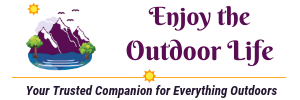Snow helmet usage has increased 236% since 2012. We did our research and found out why more people are wearing skiing and snowboarding helmets.
This post covers the facts and benefits about wearing helmets for snow sports. Our goal is to help you make an educated, and well informed decision on whether a snow helmet is right for you, or your child.

“The most surprising finding was that helmet wearers were less likely to sustain an injury of any kind than people who don’t wear them.”
- Cat Weakly in The Telegraph, July 27 2018 -
Skiing and snowboarding are some of the most thrilling and relaxing sports in the world — as are sledding and snow tubing.
Unfortunately, these sports can be dangerous, if you are not careful. Accidents occur even to the most skillful skiers and snowboarders.
And while most of these accidents don’t result in tragic or even serious injuries, you’ll still want to take all the precautions, so you don’t get hurt.
Among skiers and snowboarders, injuries to the head is the leading cause of catastrophic injury and fatality, with people who don't wear a snow helmet more likely to sustain traumatic brain injuries, concussions and other types of head injuries, as well as injuries to the rest of their body.
One of the simplest ways to ensure your safety is by putting on a snow helmet!
Quick Links - Skiing and Snowboarding FAQS
In this article we hope to answer the most frequently asked questions about why it's a good idea to wear a snow helmet. Want to go directly to a question? Click the link.

Facts About Skiing and Snowboarding Safety
Video: Skiing and Snowboarding Safety is Everyone's Responsibility — Know the Code!
Know the Code: It's Your Responsibility | Courtesy of National Ski Areas Association
Overall, snowboarding and skiing, when you use the right protective gear and follow proper safety and slope etiquette, is relatively safe.
According to National Ski Areas Association (NSAA) skiers and snowboarders have less than 1 in a million chance of receiving a catastrophic injury or dying from a trauma related to snow sports.
Even though this number seems low, we believe that even one serious injury or fatality is too much — especially if it could have been avoided.
The best helmet will go a long way in ensuring you remain safe while on the slopes.
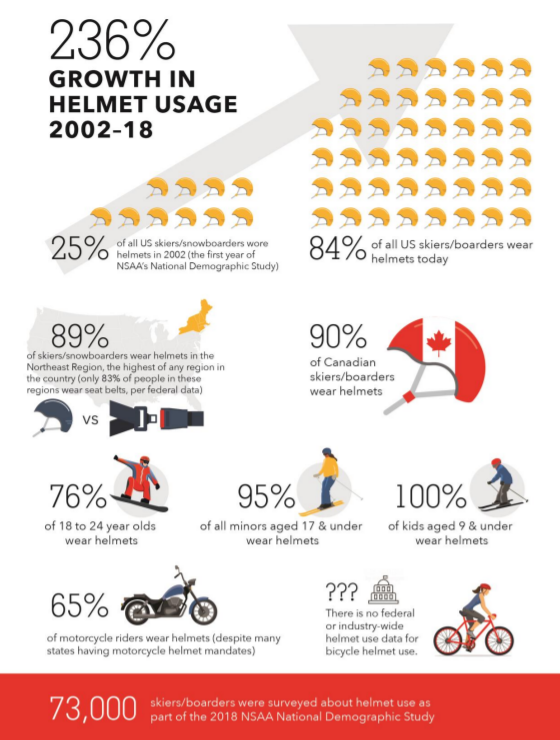
Helmet Usage and Safety Fact Sheet 2018 Infographic | National Ski Areas Association
The Good News
The good news is that over 90% of minors wear helmets while skiing and in general helmet usage has increased 236% from 2012 to 2018 (per NSAA reports). Since children are not usually as experienced as adults, this data goes to show that parents are establishing an excellent foundation for safe skiing and snowboarding.
With it's tagline, "A Helmet - It's a Smart Idea," the Lids on Kids program has gone a long way in consumer education on the importance of helmet safety.
Video: Shaun White, Professional Snowboarder Talks About How Helmets Have Changed
Shaun White, on Helmet Safety | Lids on Kids PSA
If you have kids, you can check out other Lids on Kids Public Service Announcements done by professional skiers and snowboarders here.
Let’s look at some more statistics:
Research carried out by ASTM International in 2015 revealed that between 1996 and 2012, the number of skiers and snowboarders wearing a helmet went uphill from 8% to a whopping 84%, and consequently, head injuries reduced from 8.4% to 6.8%. The research also showed that head abrasions which could be considered “substantially serious” had reduced from 4.2% to 3%.
Following the racer, Michael Schumacher's notorious ski accident in 2013, there has been a general increase in awareness of head abrasions, which has led to the increase of people wearing helmets on the slope. Mountain doctors in France found out that adult-use increased from 9% to 70% between 2005 and 2017.
The 2018 NSAA report shows that helmet usage has consistently increased for 16 consecutive years (with the major changes being for kids and teens). 100% of toddlers and children under the age of 9 are now wearing helmets. And helmets for young people between the ages of 10 and 16 went up by 90%.
During the 2017/18 season, the number of fatal incidents decreased by 19% (37 total reported). Fatalities were most frequently due to collisions with other skiers, snowboarders, trees or man-made objects.
Snow helmets, whether for skiing, snowboarding, sledding or snow tubing, are designed for safety and comfort.
The Bad News
Yes, it’s fantastic that there has been a decrease in skiing and snowboarding related deaths, but sadly, the number of catastrophic injuries increased by 15% from the 2016/17 to the 2017/18 season. Catastrophic injuries — major head injuries, significant neurological trauma, spinal cord injuries, full or partial analysis or loss of limb — are most likely to occur from collisions with other skiers or snowboarders or equipment.
On the flip side of reports by major groups like NSAA, in 2018, Nicolas Bailly, PhD, published a report that stated that while helmets protect against head abrasions such as gashes and bruises quite well, it cannot do the same for major brain injuries.
This study has caused quite a stir in the "for and against" camps — even though it also found that snow helmet wearers had lower overall rates of injuries.
The people who believe in this theory that helmets won't stop things like concussions are more likely not to wear helmets. This may be part of the reason why the percentage of helmet-wearers drops into adulthood. What’s more, many adults wrongly believe that a helmet will reduce visibility and eventually, reaction time, which means a helmet, will cause accidents more likely.
These two opposing arguments just show how the helmet debate is not ending anytime soon. The age group least likely to wear helmets? Skiers and snowboarders in the 18 to 24 age range, with only 76% using one during the 2017/18 season (per NSAA).
But seriously though, should you wear a helmet when skiing or snowboarding?
The answer is yes, you should absolutely wear a helmet while out on the slopes. The number of head abrasions on the slopes may not have declined but the severity of the injuries has undoubtedly improved.
While it’s true that a helmet doesn’t prevent all head injuries, it can have a crucial impact on the severity.
Below are some reasons why you should wear a snow helmet while out on the slopes.


Benefits of Wearing a Skiing Helmet
Video: The Mechanics Of A Crash - Why You Need a Snow Helmet
MIPS: The Mechanics Of A Crash – Multi-Directional Impact Protection System | Courtesy of Giro Snow
As discussed above in the video by top manufacturer Giro, wearing a helmet while skiing will help reduce the prevalence and severity of head abrasions such as severe concussions, fractures, and even death.
Above all, wearing a helmet gives you a sense of confidence as you know that you are protected — which will make you safer on the slopes (as long as you don't get overconfident or arrogant, thinking you are invincible with a helmet).

Benefits of Snowboarding Helmets
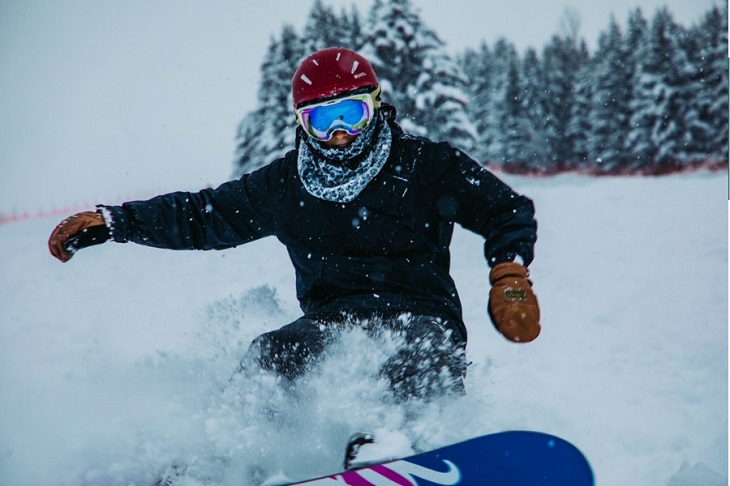
Snowboarding helmets have been proven to reduce head injuries — and they look cool!
Just like ski helmets, snowboarding helmets also help prevent snowboard injuries (and all those benefits above apply).
But while studies show that both snowboarders and skiers are prone to injuries, other studies show that snowboarders are nearly twice as likely to endure abrasions as compared to skiers.
Besides head injuries, other common snowboard injuries can be grouped into two main categories — ankle injury and upper wrist injury. Wrist injuries are prevalent among snowboarders and they can cause severe harm if not treated properly. Ankle injuries (caused by jumping and falling) are also prevalent among snowboarders and can cause serious damages too.
Helmets won't directly help with these types of injuries, but especially for beginners and children, wearing a helmet (both when snowboarding and skiing) can help reduce the "what if I get fall and get hurt" nervousness, that can cause unsafe behaviors which could actually increase the chance of falling. Confidence on the slopes is key!

"Snowboarding allows you to create your own path, and for me it was awesome because no one was telling me what to do. I could go out on the mountain and try new things and learn for myself."
- Mark McMorris, Canadian Pro Snowboarder -
Other than the medical benefits, there are also the aesthetic benefits of wearing helmets when participating in snow sports.
The popularity of this "must have" piece of gear has led them to becoming more streamlined, fashionable, and even lighter over the years. There’s a variety to choose from and you can even get a cheap snowboarding helmet that will still serve you well.
Also, several manufacturers are upping their game by providing more protection than market standards. And don't forget your snow goggles!

5 Common Myths for Not Wearing a Helmet
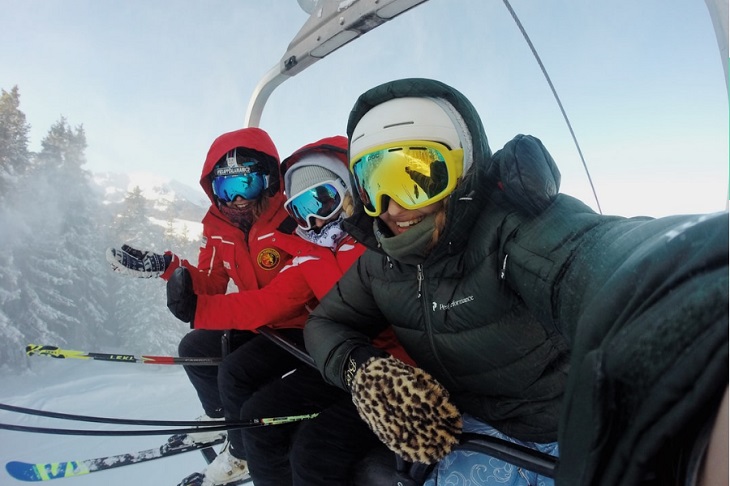
"Once you take your first ride up a lift your life will be changed forever." | Warren Miller
Unless you are have a child skier and are in New Jersey, there are currently no State laws (as of this writing) that make wearing a snow helmet while skiing or snowboarding mandatory.
There are some ski resorts that do require helmets to use their slopes, with some requiring them just for children and others for everyone. Just about every professional skiing and snowboarding association and competition requires helmets.
Despite no laws requiring helmets for children (except NJ), safety-wise we were happy to see that 100% of parents with kids under the age of 9 are following the NSAA and American Academy of Pediatrics advice for all children and adolescents to wear helmets in snow sports.
Unlike laws that require motorcycle helmets and seat belts (depending on your state), whether or not to wear a helmet is something that you will have to decide for yourself.
Make sure your decision is based upon facts, not myths!
Disputing the Myths about Wearing Snowboarding and Skiing Helmets
Myth 1: Those Who Wear a Snow Helmet for Become Riskier
The benefits of using helmets have been the topic of remarkable debate for several years now. Proponents cite a reduced number of severe injuries and increased safety, while the opponents argue that skiers wearing helmets tend to take greater risks, believing they are fully protected and do not need to take care.
Although this may be true, these same skiers are typically risk-takers in all areas of their lives, so it has nothing to do with them wearing helmets.
Myth 2: Snow Helmets Cause Obstructed View
When it comes to your vision on the slopes, there are two major concerns—peripheral vision and reaction time. While at the slopes, it’s important that you see everything and everyone that is coming at you from different directions so that you can slow down and let them pass or get out of the way.
Now, those who don’t wear helmets claim that wearing one slows down their senses, reduces their peripheral vision, which slows down their response time.
The truth is, helmets take nothing away from a skier’s performance; nor do they compromise vision and response time. Besides, the market is currently filled with high-quality helmets that contain the specific specs that you want.
Myth 3: Only Children and Beginners Need Helmets for Skiing or Snowboarding
Anyone, despite the age or experience level, can fall victim of ski accidents. In fact, your experience could mean that you are too confident and are, therefore, moving faster, which increases the probability of hitting your head hard.
Myth 4: Snow Helmets are Heavy, Hot and Stuffy
With the market full of lighter and funkier helmet designs, the old “wind in the hair” narrative doesn’t hold water anymore. Unless you wear a beanie under them, helmets are made with a technology that prevents them from being hot and stuffy.
So, if this is an issue for you, choose a design with ventilation systems to keep you warm, or allow in cool air.
Remember, the more vents a helmet has, the more powerful cooling when your head warms up. Also, assess whether the vents are pluggable or if there is skier-controlled venting that you can easily adjust while racing so you don’t have to remove the helmet.
Myth 5: Wearing a Helmet Doesn’t Really Make a Difference in Case of an Accident on the Slopes
Head injuries usually occur when you hit non-moving objects such as snow, ice, rocks, or trees on the ground. These kinds of accidents are actually the main causes of skiing and snowboarding deaths.
Now, if you hit a branch as you race through the trees, it’s obvious that your skull is going to be better guarded if you were wearing a helmet than if you were not wearing one or you only had a mere bobble hat on.
The greatest controversy is on the falls and concussions that occur when racing at high speeds as different researches clash with just how much protection your helmet will offer you. But, however minimal this may be (even if it’s as low as 20%), it is still worth wearing a helmet for.

A Few Final Words...
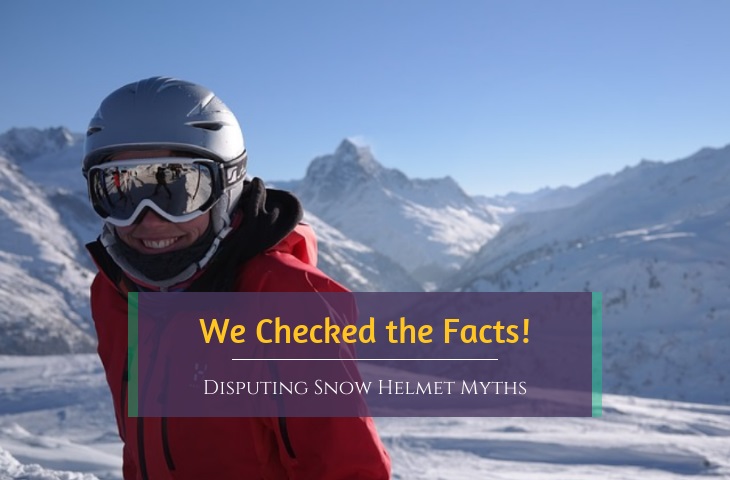

“The foundational skills of snowboarding are what pay off in the long run. That's something I've been able to build over time, and that's benefited me a lot.”
- Kelly Clark, American Olympic Gold Medalist -
To wrap up, injuries caused by skiing and snowboarding can lead to serious problems among snow sports enthusiasts, including morbidity and mortality.
A 2011 research study published in News Medical Journal revealed that 5% of those who wore helmets suffered skull rupture as opposed to almost 37% of those who didn’t. Helmet use also influenced the seriousness of the injury, with non-helmeted individuals experiencing a more depressed and dangerous fracture.
While it’s true that a helmet won’t be of great help when a skier has encountered a blunt trauma to the head, no evidence exists to show that a helmet can make a blunt trauma or concussion worse. In fact, the recent studies show a reduction in abrasion since a good number of skiers and snowboarders started wearing helmets.
Besides, helmets are comfortable and affordable, so there is no excuse of not wearing one while on the slopes.
Choosing a Skiing or Snowboarding Helmet that Fits
The better and more comfortable the helmet, the more likely you or your children are to wear it — so make sure you get one that fits properly.
While ski and snowboard helmets are pretty much interchangeable, using a helmet designed for another sport, like a bicycle helmet, will not provide you with the right kind of protection.
Video: Basics of Choosing the Right Helmet and Goggles for Skiing and Snowboarding
Tutorial: The 101: Buying a Ski Helmet and Goggles | Courtesy of Outside
Rather than reinvent the wheel (and make this post even longer), we are going to turn you over to some resources put together by some experts in the field.
The video above is a good place to start.
Burton, a leading manufacture of skiing and snowboarding helmets, has put together an informative chart with tips to consider when purchasing a snowboarding or skiing helmet for both adults and children helmet for yourself and your child.
You may also want to read How to Choose a Snow Helmet, from Backcountry.
By the way, if you plan on doing some serious tubing or sledding on the slopes, it's also a good idea to consider a helmet, especially if you are using one of the newer sleds or toboggans capable of hitting high speeds.
Be safe on the slopes this year — wear a helmet and #RideAnotherDay!
Safety First - Johnson Family Shares the Loss of 5 Year-Old Daughter Hit By Another Skier
#RideAnotherDay National Ski Areas Association | Read Full Story
